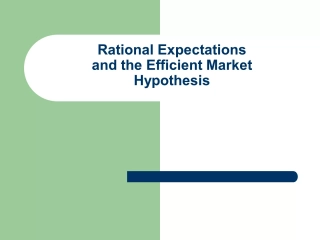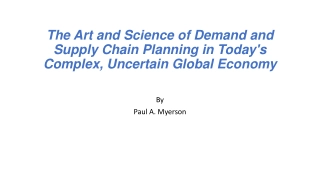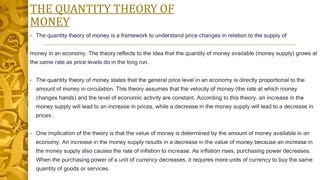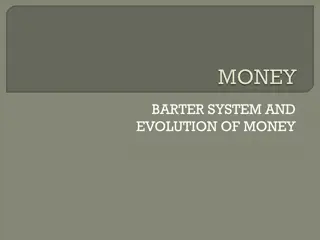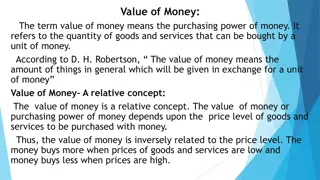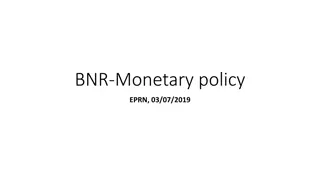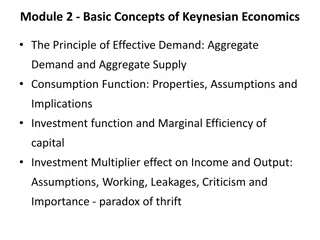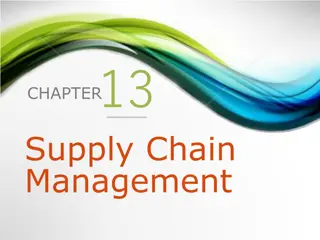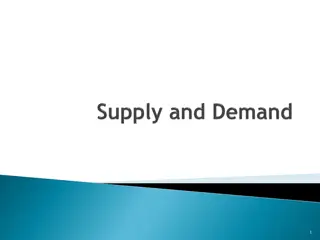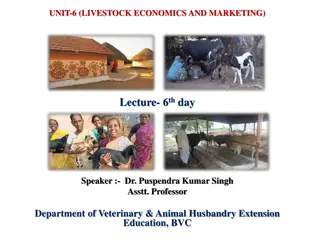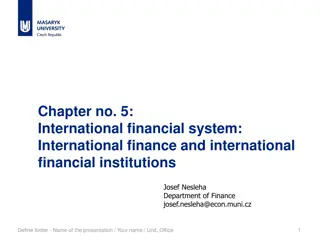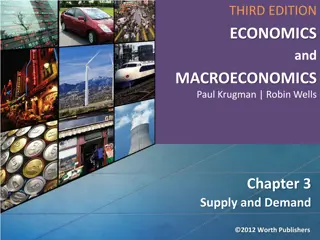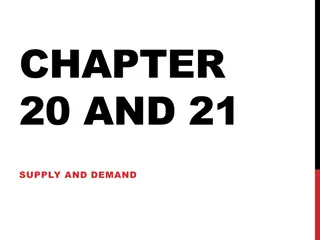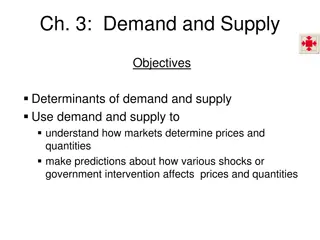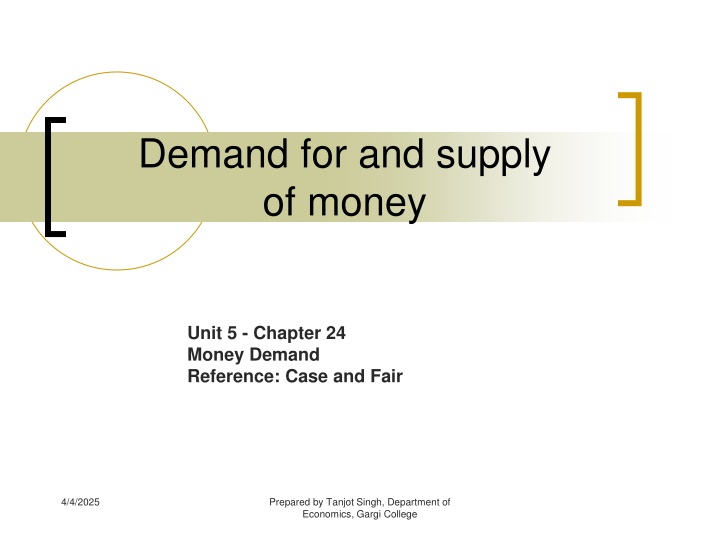
Money Demand, Supply, and Theory - Explained
Explore the concept of money, its functions, kinds, measures of supply, and the Quantity Theory of Money (QTM) including Fisher's Equation. Learn how variations in the quantity of money impact prices, income, and interest rates through different approaches in economics.
Download Presentation

Please find below an Image/Link to download the presentation.
The content on the website is provided AS IS for your information and personal use only. It may not be sold, licensed, or shared on other websites without obtaining consent from the author. If you encounter any issues during the download, it is possible that the publisher has removed the file from their server.
You are allowed to download the files provided on this website for personal or commercial use, subject to the condition that they are used lawfully. All files are the property of their respective owners.
The content on the website is provided AS IS for your information and personal use only. It may not be sold, licensed, or shared on other websites without obtaining consent from the author.
E N D
Presentation Transcript
Demand for and supply of money Unit 5 - Chapter 24 Money Demand Reference: Case and Fair 4/4/2025 Prepared by Tanjot Singh, Department of Economics, Gargi College
What is money? Money is anything that is generally acceptable as a means of payment in the settlement of all transactions General acceptability unique feature of money Money is what money does Purchasing power 4/4/2025 Prepared by Tanjot Singh, Department of Economics, Gargi College
Functions of money Medium of exchange Measure of value /unit of account Standard of deferred payments Store of value 4/4/2025 Prepared by Tanjot Singh, Department of Economics, Gargi College
Kinds of money Fiat money (legal tender) Coins Currency notes Fiduciary (credit) money Deposits Bank deposits Demand and time deposits Post office deposits 4/4/2025 Prepared by Tanjot Singh, Department of Economics, Gargi College
Measures of money supply M1 = C + DD + OD M2 = M1 + savings deposits with post office savings banks M3 (AMR) = M1+ net time deposits of banks M4 = M3 + total deposits with post office savings organization 4/4/2025 Prepared by Tanjot Singh, Department of Economics, Gargi College
Quantity theory of money Variations in quantity of money impacts prices, money and real income, rate of interest Two approaches Quantity theory of money Keynesian theory Quantity theory Irving Fisher s transactions version Cambridge cash balances approach 4/4/2025 Prepared by Tanjot Singh, Department of Economics, Gargi College
Fishers QTM M*V = P*T M stock of money depends on monetary system V velocity of circulation average number of times a unit of money changes hands in a given period P average price of market transactions T physical volume of transactions Assuming V and T constant, direct relation between M and P Ms = Md Economics, Gargi College 4/4/2025 Prepared by Tanjot Singh, Department of
Cash balances approach Marshall and Pigou Md = K P y K behavioural constant ratio of money income people like to hold in the form of money measured in time units 0<K<1 P average price level y real income In equilibrium, Md = Ms K is reciprocal of V (turnover per time period) Economics, Gargi College 4/4/2025 Prepared by Tanjot Singh, Department of
Money market Money as an asset Money market Demand consumers general public Supply producers of money government, monetary authority and banking system Equilibrium in money market 4/4/2025 Prepared by Tanjot Singh, Department of Economics, Gargi College
Demand for money Sum total of all the money demanded by general public including households and firms Demand for money is demand for real balances i.e. purchasing power of money Why do people demand money? or What are the determinants of people s demand for money? Neoclassical theory cash balances approach Keynesian theory Economics, Gargi College 4/4/2025 Prepared by Tanjot Singh, Department of
Keynesian theory of Md Why do people demand money when there are other non-money financial assets that earn income for holders? Money demand due to two characteristics general acceptability as means of payment and perfect liquidity Motives for demanding money Transactions motive Precautionary motive Speculative motive 4/4/2025 Prepared by Tanjot Singh, Department of Economics, Gargi College
Contd. Md = f (Y, r) Y income r rate of interest Transactions & precautionary demand depends on Y similar to Cambridge approach Speculative demand most important contribution of Keynesian analysis to monetary theory depends on r Tobin s argument demand for money depends on expected yields and riskiness of the yields of other assets Economics, Gargi College 4/4/2025 Prepared by Tanjot Singh, Department of
Contd. Downward sloping aggregate demand for money w.r.t. rate of interest Liquidity trap a situation in which at a certain low rate of interest, demand for money becomes perfectly elastic People not willing to hold money in bonds and convert to cash Increase in money supply gets trapped as people hoard money 4/4/2025 Prepared by Tanjot Singh, Department of Economics, Gargi College
Contd. Demand for and supply of money affect economic activity through r and changes in real investment depending on r Determination of rate of interest intersection of demand for and supply of money Ms determined exogenously by the monetary authority 4/4/2025 Prepared by Tanjot Singh, Department of Economics, Gargi College
Supply of money Ordinary money (M) and high-powered money (H) M = C + D H = C + R Relation between M and H H is the monetary base that consists of currency and banks reserve deposits with central bank 4/4/2025 Prepared by Tanjot Singh, Department of Economics, Gargi College
Contd. H theory of money supply Hs is policy determined i.e. given exogenously to public and banks Hd = Cd + Rd Cd = c . D, where c is the currency deposit ratio, a behavioural ratio that expresses people s preferences between currency and deposits Rd required reserves and excess reserves Rd = r. D, where r is the reserve deposit ratio, ratio of reserves to total deposits of banks 4/4/2025 Prepared by Tanjot Singh, Department of Economics, Gargi College
Money multiplier Hd = Cd + Rd Hd = c. D + r. D = (c + r) D M = C + D = (1 + c) D In equilibrium, Hs = Hd Money multiplier = mm = M / H mm = (1 + c ) / (c + r) M = {(1 + c ) / (c + r)}. H mm depends on currency deposit ratio, c and reserve deposit ratio, r mm > 1 mm is larger the smaller is r mm is larger the smaller is c 4/4/2025 Prepared by Tanjot Singh, Department of Economics, Gargi College

